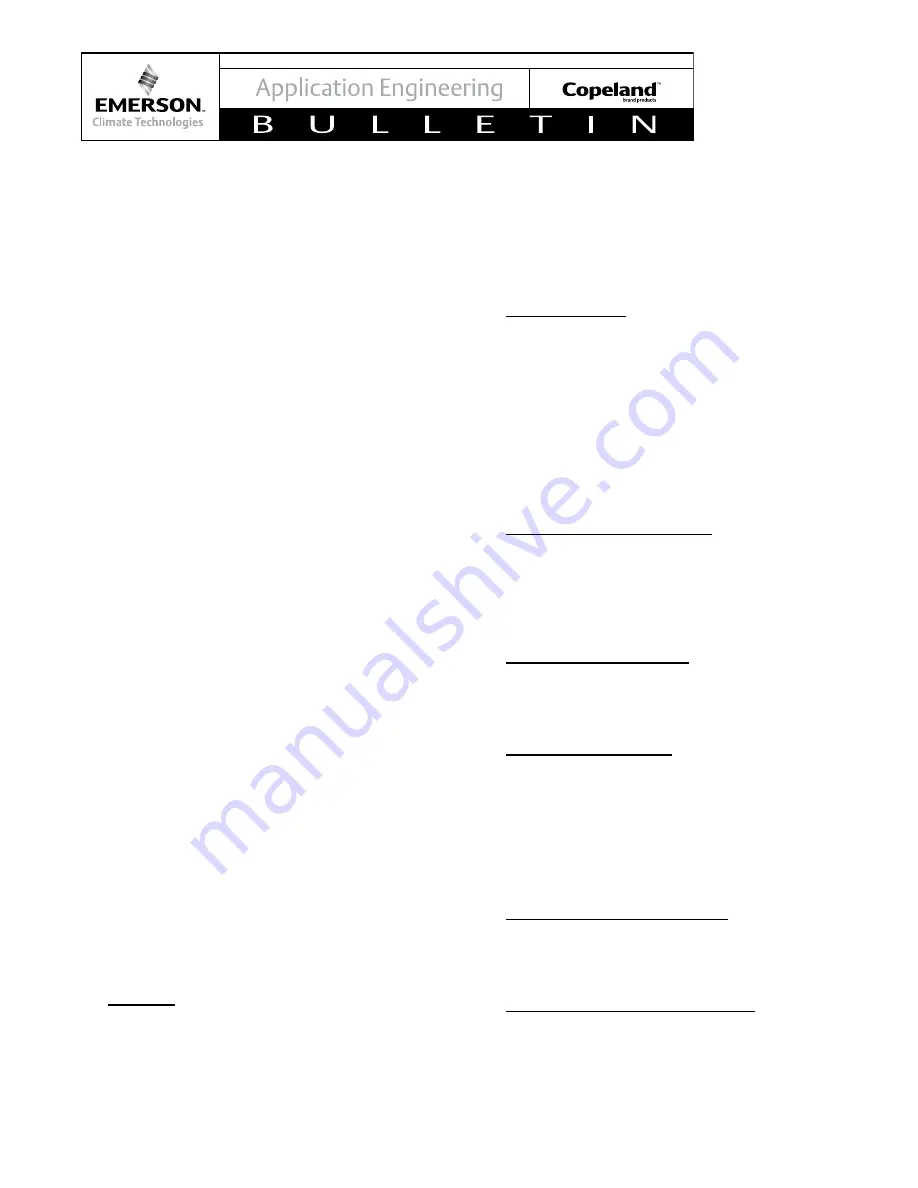
5
© 2016 Emerson Climate Technologies, Inc.
AE4-1402 R4
and a rotor embedded with high energy permanent
magnets. The input voltage is a series of pulses of
varying frequency at 120 degree intervals between
phases.
Oil Pump
The variable speed scroll is equipped with an oil pump
to ensure an adequate supply of oil to the bearing
system throughout the operating speed range of 1000
to 7200 RPM.
APPLICATION CONSIDERATIONS
Compressor Temperature Protection
A discharge line thermistor must be used to protect the
compressor. The drive will shut down the compressor
when the thermistor temperature exceeds 275°F
(135°C). Please see the section
Troubleshooting
Scroll Temperature Trip
for more information on the
discharge line thermistor. Refer to
Table 1
for more
information.
Variable Speed Drive Options
Third Party Drive
The customer may use a third party drive. A third
party control system must include a discharge line
thermistor that will signal the drive to shut down if
the temperature exceeds 275°F (135°C), a soft start
and stopping routine, an oil boost cycle similar to the
Emerson EVC1 oil boost cycle, every two hours at
3600 RPM if operating below 1800 RPM, and include
the operating envelope in
Figure 3
. A third party drive
must include short cycle protection similar to the
Emerson EVC1 short cycle protection. Refer to
Table
2
for compressor motor specifications and
Table 5
for
speed adjustment requirements.
Emerson EVC1 Drive Features
It's recommended that the Emerson variable
speed drive (VSD) be used with the variable speed
compressor. The Emerson VSD has custom built
in features that may improve the longevity of the
compressor and efficiency of the system. Refer to the
Emerson EVC1 Drive user guide for more information.
(www.controltechniques.com)
Oil Boost
The Emerson EVC1 drive includes an oil boost
cycle when the compressor operates between 1000
and 1800 RPM. The oil boost cycle starts once the
compressor operates for two hours between 1000
and 1800 RPM. During the oil boost cycle, the drive
forces the compressor to run for five minutes at
3600 RPM. After operating for five minutes at 3600
RPM, the drive allows the compressor to operate
between 1000 and 1800 RPM.
Figure 3
shows the
operating conditions of the oil boost cycle.
Motor Protection
The Emerson EVC1 drive includes motor protection
features for the compressor. The drive sets the
maximum current limit, low voltage fold back which
allows the compressor to ride through low voltage
situations, which helps keep the compressor running
to avoid nuisance trips. The drive also includes lost
rotor avoidance and locked rotor detection. The lost
rotor avoidance uses a custom algorithm to evade
a speed error by reducing the speed by 200 RPM
to 're-catch' the rotor.
Reverse Rotation Protection
The Emerson EVC1 drive helps prevent reverse
rotation of the compressor. The drive checks for
reverse rotation during the first startup and looks
for a miswire at the compressor's motor. The drive
utilizes a torque profile method at startup.
Missing Phase Protection
The Emerson EVC1 drive includes compressor
missing phase protection. The drive checks for a
missing phase connection.
Short Cycle Protection
The Emerson EVC1 drive includes short cycling
protection which checks the duration of the runtime
and quantity of short cycles. The amount of runtime
and the maximum allowable short cycles in 24
hours is adjustable. The default maximum short
cycles in 24 hours is four. The default short cycle
time is five minutes.
Resonance Avoidance Feature
The Emerson EVC1 drive includes a resonance
avoidance feature which has the ability to skip a
single frequency or a range of frequencies.
Discharge Temperature Protection
The thermistor will signal the drive to shut down if
the temperature exceeds 275°F (135°C).






































